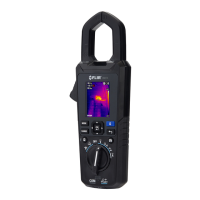3. Insert the black probe lead into the negative COM terminal and the red probe
lead into the positive terminal.
4. Touch the tips of the probe across the circuit or component under test.
5. If the resistance is < 30Ω the meter beeps. If the resistance is > 150Ω the meter
will not beep. > 30Ω but < 150Ω the beeping will stop at an unspecified point.
9.14 Classic Diode Test
Warning: Do not perform diode tests before removing the power to the diode or other
devices under test during a measurement. Injury to persons can occur.
1. If not already selected, choose CLASSIC Diode test mode in the General Settings
menu (Section 7.1.1, Diode Smart/Classic).
2. Set the function switch to the diode position. Use the button to
select the diode function. The diode indicator will appear.
3. Insert the black probe lead into the negative COM terminal and the red probe
lead into the positive terminal.
4. Touch the tips of the probe across the diode or semiconductor junction in one
polarity (direction) and then in the opposite polarity as shown in Fig. 9-6.
5. If the reading is between 0.400 and 0.800V in one direction and OL (overload) in
the opposite direction, the component is good. If the measurement is 0V in both
directions (shorted) or OL in both directions (open), the component is bad.
Fig. 9-6 Classic Diode Test

